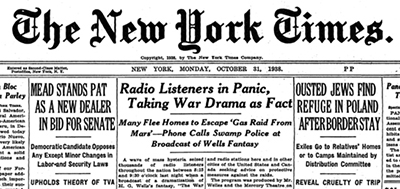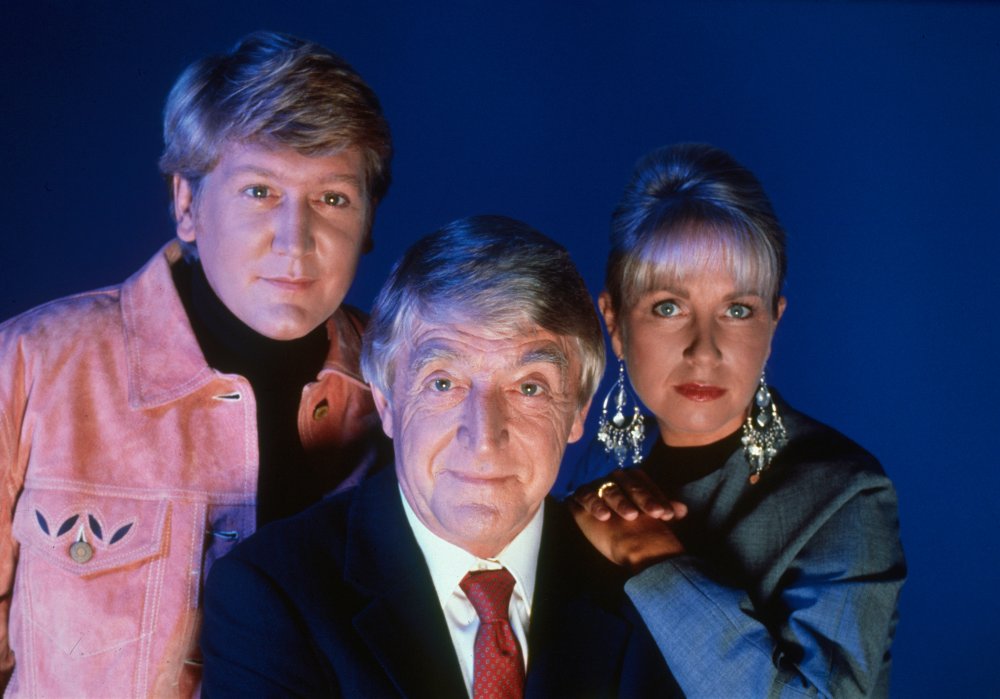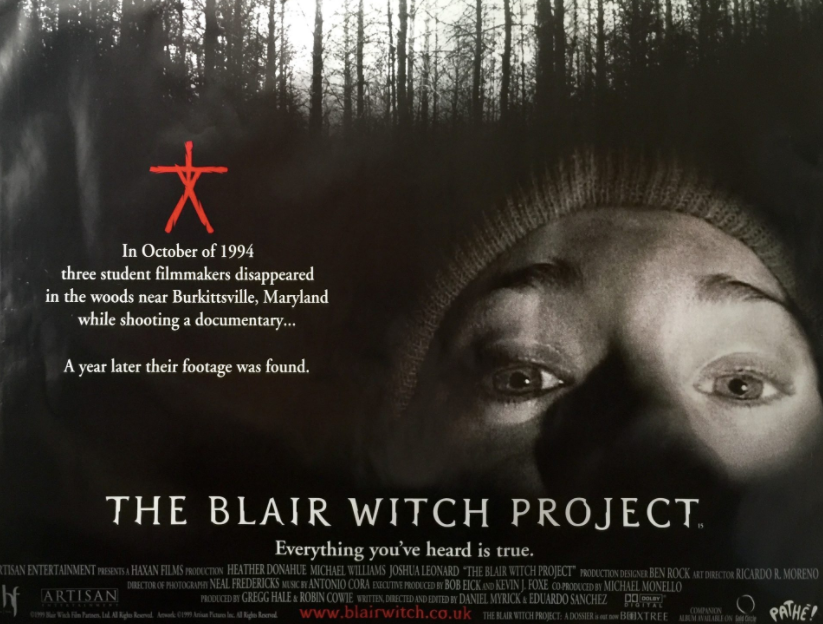Halloween is fast
approaching, but for shops, it is the start of the build up to Christmas.
Seriously, there are already Christmas displays in Tesco and Sainsbury. Wait
until November 1st for goodness sake!
Anyway, with Halloween soon, and after watching American Gods again, I was inspired to write this article to
discuss something spooky, but also very fascinating. Our ability to be easily
tricked into thinking a piece of fiction is real and actually happening. Now,
we’re not here to psychoanalyse mankind or any such nonsense. We’re here to
look back at three pieces of media that terrorised their audiences, and the
public reaction and backlash that followed. The cleverness of these works was
that they were treated as real events, both within the scripts, scheduling, and
the reactions from the public.
“Mass delusions are as old as I am.
I was there when the Martians invaded in 1938. What a panic. Powerful panic.
Now there are starmen waiting in the sky. They believed it was true, and it
was.” – Media, American Gods.
WAR OF THE WORLDS
The War of the Worlds was an infamous radio drama, narrated by Orson Welles, and aired in America in 1938. Adapting H.G. Wells novel, the play was a part of the anthology series “The Mercury Theatre on the Air”, broadcast over CBS on October 30th, 1938 for Halloween. The drama’s format was a simulated live news broadcast, which was interrupted by reports of Martians invading the United States. The idea for the play came from a British radio hoax that occurred in 1926, with a fictional riot occurring in London. A similar concept happened during an Australian broadcast in 1927.
The show lasted forty minutes, and in that space, listeners were
convinced that aliens were invading, men travelled long distances, war broke
out, cabinet meetings occurred, and savage, violent battles occurred on land
and in the sky between soldiers and the invading Martians. Interestingly, the
play actually started with an alternate version of the novel’s opening
paragraphs – so, you’d think some listeners would have realised this broadcast
was fictional. At the end of the broadcast, during which panic broke out,
Welles threw in a last minute disclaimer, revealing the whole thing was a
Halloween ruse.
The CBS producers, staff, and actors were flooded with angry calls,
panicked executives and censors ordering the broadcast to either be shut down,
or interrupted to make it clear the play was fictional. Police allegedly
stormed the studio to arrest Orson Welles and co. for causing mass panic.
Journalists raced to confront those involved with the broadcast to either
confirm or deny the deaths and mass mayhem reported in the play, and then
interrogate them on the reasoning behind their actions. There have been suggestions
that the nationwide mass hysteria was not as widespread as history and
journalism have suggested. Welles received quite the telling off from the angry
mob brigade, ushering an apology to the press and public for the chaos caused.
In 1940, Orson Welles and H.G. Wells actually met and had a radio
interview in San Antonio together. Wells dismissed the alleged public hysteria
with good humour, believing it was simple Halloween fun. The two and the host
discussed the nature of the radio play and the public reaction, concluding it
was simply America responding as they would to a playful prank. H.G. suggested
that America could still get away with messing around with the idea of terror,
since World War II had not arrived at their doorstep yet, and they were dealing
with it in a manner. Orson Welles then responded with, “Until it ceases to be a
game.”
Nowadays, The War of the Worlds radio play has been mythologised thanks
to its exaggerated reaction from the public. It had a limited reach for an
audience, and the widespread lunacy was not as prominent as the newspapers
suggested.
But, history repeats, only this time it was in the United Kingdom where
mass hysteria caused mayhem on Halloween.
GHOSTWATCH
The BBC’s Ghostwatch, written by Stephen Volk, aired on October 31st, 1992. A drama-mockumentary stylised as a live broadcast on BBC One, Ghostwatch was actually recorded weeks in advance, and like War of the Worlds, it was mistaken for an actual event, and received quite the backlash from the gullible, frightened public.
Ghostwatch was treated as a live broadcast, focusing on “the most haunted
house in Britain”, and the presenters were performing an on-air investigation
into the existence of the supernatural, with the hope of seeing an actual ghost.
In the fictional premise, Pamela Early lived on Foxhill Drive, Northolt,
Greater London, with her two daughters Suzanne and Kim. The family have been
tormented for months by a threatening poltergeist they have nicknamed Mr.
Pipes, who appears as a disfigured man in a dress, bangs on the pipes (hence
the name), and lurks in the house’s barricaded cellar. The two girls are the
victims of Pipes – Suzanne has been repeatedly possessed by him, while the
other appears to have clairvoyant powers and repeatedly claims that “Pipes
wants to see everybody”.
On hand are a handful of familiar icons of British television – Michael
Parkinson was the sceptical presenter in the studio, Craig Charles (of Red Dwarf) was on the street
interviewing the locals, while Sarah Greene played the role of the intrepid
reporter, venturing into the house with her film crew to search for ghosts. During
all this, Parkinson says the viewers get call the BBC phone switchboard and
speak to Mike Smith, Greene’s husband, and share their own ghost stories. Those
who called the number were informed via recording that it was actually a work
of fiction and not live. The problem was that the switchboard did get
overloaded, so few people truly learnt the actual nature of the programme.
As the show went on, things started getting freaky in the house.
Throughout the programme, guests could potentially spot Mr. Pipes standing
menacingly in the background of certain scenes. His backstory is revealed to be
terrifying, actually a pedophilic lunatic who hung himself in the house’s
cellar and his face was eaten by cats. But, then it turns out he was possessed
by the ghost of a Victorian-era child killer named Mother Seddons, hence why
Pipes wore a dress. There is even a hint that these events in the neighbourhood
have been going on for centuries, like Pennywise from It is responsible for everything.
More and more viewers call and claim they are seeing Pipes in the house.
Suzanne gets possessed again, Greene’s sound operator gets a mirror smashed
over his head, and then all hell breaks loose in the studio. It becomes clear
that Mr. Pipes has been using the broadcast to create a nationwide séance
circle, terrorising the nation through their TV sets. Sarah Greene is sucked
into the cellar and vanishes, whilst Parkinson is possessed by the phantom
cats, ending the broadcast.
Much like War of the Worlds, many viewers missed the titles, including
that it was written by Stephen Volk, clearly indicating it was a work of
fiction. Like the backlash with the radio drama, many people were angered that
they had been deceived, that the eternally trusted BBC had aired something so
scary (on Halloween), etc. The BBC received many frightened and angry calls
during and after the programme. The producers were dragged onto the show BiteBack to be punished by a verbal
firing squad. Sarah Greene, alive and well, popped up in CBBC to assure
children she did not get sucked into hell. Allegedly, people were hospitalised,
three pregnant women went into labour, and one woman got so irate, she demanded
that compensation for a pair of new jeans for her husband…
Still, there was a serious incident where a young man with learning
difficulties committed suicide five days after Ghostwatch aired, and his suicide note appeared to lay the blame on
the show. Ghostwatch has subsequently
been considered non-existent by the BBC, never airing it on television again,
though they have re-released the mockumentary on DVD several times over the
years. The show has had influence on many other films and shows. The silly
ghost-hunting shows on both sides of the Atlantic took influence from Ghostwatch, and films like Paranormal Activity, and The Blair Witch Project. Speaking of
which…
THE BLAIR WITCH PROJECT
In 1994, three filmmakers ventured into the Black Hills Forest near
Burkittsville, Maryland, in search of the mythological Blair Witch. They were
never seen again. A year later, film footage was discovered in the woods and
the truth behind their disappearance was revealed in one of the scariest films
of all-time.
Okay, that is a load of rubbish, but that was the genius of the movie.
The low budget found footage film had such a brilliant and convincing story,
that many people believed the footage was real. In the film, Heather, Josh, and
Mike (played by actors who are very much alive) get lost in the woods and
tormented by an unseen entity, who may or may not be the Blair Witch. The whole
film is fictional and incredibly well executed. The internet was still in its
infancy, and the viral marketing used for The
Blair Witch Project was fantastic. An elaborate lore was crafted around the
witch and her curse over Burkittsville – imagined in the film as being built
over a fictional, abandoned town called Blair, who trialled the witch, Elly
Kedward, and left her to die in the woods.
The marketing and presentation of the film as a true story was so
convincing, that hordes of tourists flooded Burkittsville to find the truth –
even though it was complete fiction. Bad news for Burkittsville, who have
forever been associated with the Blair Witch. Heck, someone even stole the
town’s population sign, since it appeared in the movie, and they had to replace
it. The Blair Witch Project gained a
rather crumby sequel, Book of Shadows,
and included the reactions of both tourists and Burkittsville in the plot. The
film gained a second sequel in 2016. The
Blair Witch Project, while not the first found footage movie, certainly
proved to be the most successful. Films like Rec and Cloverfield were
inspired by its success.
It is fascinating how this sort of metafiction pops up every now again,
and has the same or a similar impact upon the public imagination. The War of the Worlds allegedly caused
mass hysteria, in likely relation to the outbreak of war. Ghostwatch, while not an actual live recording, was cleverly
treated as one, and the unsuspecting BBC viewership had never experienced such
a show before. And The Blair Witch
Project used such a brilliant marketing campaign to convince people to see
the movie. I suspect the media of the 1930s greatly exaggerated the reaction of
the radio play, and a lot of people missed the opening titles of Ghostwatch, which stated the show was a
work of fiction. And Blair Witch…well,
I guess some folks really enjoyed the film, and some really bought its
authenticity.
I wonder what will happen if and when another one of these inventive “mass
hysteria” pieces of media occurs.




No comments:
Post a Comment